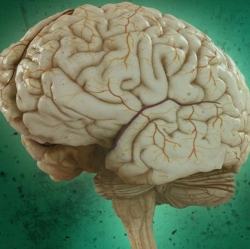
“The human brain has 86 billion or so neurons all trying to talk to each other in this incredibly messy, noisy and electrochemical soup,” said study author Bradley Voytek. “Our results help explain the mechanism for how brain networks quickly come together and break apart as needed.”
Working with cognitively healthy epilepsy patients, Voytek and fellow researchers at UC Berkeley’s Helen Wills Neuroscience Institute used electrocorticography (ECoG), which places electrodes directly on the exposed surface of the brain, to measure neural oscillations as the patients performed cognitively challenging tasks. This showed how the rhythms control communication between brain regions. They found that as the mental exercises became more demanding, theta waves at 4–8 Hertz (cycles per second) synchronized within the brain’s frontal lobe, enabling it to connect with other brain regions, such as the motor cortex.
“In these brief moments of synchronization, quick communication occurs as the neurons between brain regions lock into these frequencies, and this measure is critical in a variety of disorders,” said Voytek, an assistant professor of cognitive science at UC San Diego who conducted the study as a postdoctoral fellow in neuroscience at UC Berkeley. There are five types of brain wave frequencies, Gamma, Beta, Alpha, Theta and Delta, and each are thought to play a different role. For example, Theta waves help coordinate neurons as we move around our environment, and thus are key to processing spatial information.
In people with autism, the connection between Alpha waves and neural activity has been found to weaken when they process emotional images, according to Voytek. And people with Parkinson’s disease show abnormally strong Beta waves in the motor cortex, locking neurons into the wrong groove and inhibiting movement. Fortunately, electrical deep brain stimulation can disrupt abnormally strong Beta waves in Parkinson’s and alleviate symptoms,
For the study, epilepsy patients viewed shapes of increasing complexity on a computer screen and were tasked with using different fingers (index or middle) to push a button depending on the shape, color or texture of the shape. The exercise started out simply with participants hitting the button with, say, an index finger each time a square flashed on the screen. But it grew progressively more difficult as the shapes became more layered with colors and textures, and their fingers had to keep up.
As the tasks became more demanding, the oscillations kept up, coordinating more parts of the frontal lobe and synchronizing the information passing between those brain regions. “The results revealed a delicate coordination in the brain’s code,” Voytek said. “Our neural orchestra may need no conductor, just brain waves sweeping through to briefly excite neurons, like millions of fans in a stadium doing ‘The Wave.’”
